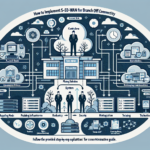Best Practices for Managing IT Infrastructure During Mergers: A Step-by-Step Guide from the Datacenter Floor
Mergers and acquisitions (M&A) are some of the most challenging events an IT department can face. Beyond integrating systems, the real complexity lies in unifying two distinct infrastructures — often with different standards, vendors, and operational cultures — without disrupting business continuity. In my 20+ years managing enterprise IT infrastructure through multiple high-stakes mergers, I’ve seen both flawless integrations and costly missteps. This guide consolidates proven strategies and technical best practices to ensure your IT infrastructure merge is seamless, secure, and future-ready.
1. Conduct a Comprehensive IT Infrastructure Audit
Why it’s critical: During a merger, hidden dependencies and undocumented configurations are your biggest risk.
Pro-Tip: Never rely solely on the documentation provided by the other party. In one merger I managed, we discovered a legacy storage array running mission-critical financial workloads that wasn’t listed in any asset inventory — and it was nearing end-of-life.
Step-by-Step:
1. Inventory Hardware — Servers, storage arrays, network switches, firewalls, and backup appliances.
2. Catalog Software & Licensing — Windows/Linux versions, virtualization platforms (VMware, Hyper-V, KVM), Kubernetes clusters, and proprietary applications.
3. Map Data Flows — Identify cross-site replication, backup targets, and API integrations.
4. Assess Compliance — Verify adherence to standards like ISO 27001, SOC 2, or GDPR.
Command-line tip for asset discovery in Linux:
bash
sudo lshw -short
sudo dmidecode | grep "Product Name"
2. Align on Infrastructure Standards Early
When two companies merge, it’s common to find mismatched virtualization platforms or incompatible storage backends. Standardization reduces maintenance overhead and improves scalability.
In my experience: One merger stalled for weeks because the acquirer used vSphere 7 while the acquired company had hundreds of VMs on VMware 5.5, which was out of support. We had to stage an interim migration before any consolidation could happen.
Best Practices:
– Choose a primary virtualization platform (VMware, Hyper-V, KVM) and plan phased migration.
– Standardize OS versions to minimize patch management complexity.
– Align Kubernetes distributions (e.g., upstream K8s, OpenShift, Rancher) to avoid API incompatibilities.
3. Secure Before You Merge
Security risks multiply during mergers due to increased network interconnectivity and expanded attack surfaces.
Checklist:
– Isolate networks until you have vetted endpoints and identities.
– Perform credential rotation for all privileged accounts.
– Audit firewall rules to prevent unintended lateral movement.
– Run vulnerability scans using tools like Nessus or OpenVAS before enabling cross-site VPNs.
Example: Creating a temporary isolated network in Cisco:
bash
conf t
vlan 999
name MERGER_ISOLATION
exit
interface GigabitEthernet0/1
switchport access vlan 999
exit
4. Plan Data Migration with Minimal Downtime
Data migration is where most merger IT projects fail. The key is to design migrations that are incremental, reversible, and validated.
In my experience: We once migrated a large PostgreSQL database over the weekend using logical replication, allowing the old system to remain live until validation was complete. This avoided a costly rollback.
Best Practices:
– Use replication tools (e.g., rsync, pglogical, VMware vMotion) for live migrations.
– Implement checksum verification after transfer.
– Schedule migrations during low-traffic periods.
– Always have a rollback plan documented and tested.
5. Consolidate Backup & Disaster Recovery Strategies
Merging backup systems without careful planning can leave data unprotected.
Pro-Tip: Maintain dual backup systems during the transition, even if it means extra costs, until you are certain the consolidated backup is reliable.
Action Steps:
1. Audit backup software versions (Veeam, Commvault, NetBackup).
2. Verify retention policies align with legal and compliance requirements.
3. Test restores from both environments before decommissioning legacy systems.
Example Veeam PowerShell command to list all jobs:
powershell
Get-VBRJob | Select Name, LastResult, LastRun
6. Address Cultural and Operational Differences
Technology integration can fail if operational processes are ignored.
In my experience: One merger had identical hardware but wildly different change management processes — leading to unauthorized reboots during production hours.
Best Practices:
– Align ITIL processes (Change, Incident, Problem management).
– Create a unified ticketing and monitoring system.
– Conduct joint training sessions to harmonize standards.
7. Validate and Optimize Post-Merge
Once infrastructure is merged, optimization is key for performance and cost efficiency.
Checklist:
– Revisit VM resource allocations to avoid over-provisioning.
– Optimize Kubernetes deployments with node affinity rules to balance workloads.
– Consolidate licensing agreements to reduce costs.
Example Kubernetes affinity configuration:
yaml
affinity:
nodeAffinity:
requiredDuringSchedulingIgnoredDuringExecution:
nodeSelectorTerms:
- matchExpressions:
- key: region
operator: In
values:
- us-east
Final Thoughts
Merging IT infrastructures is not just a technical challenge — it’s an exercise in risk management, communication, and strategic planning. The most successful integrations I’ve led were those where security isolation, standards alignment, and incremental migrations were prioritized over rushing to “just make it work.”
When done right, a well-managed IT merger not only avoids downtime and security incidents but also sets the stage for a more unified, resilient, and cost-effective infrastructure.
[Placeholder for diagram: "Merged IT Infrastructure Architecture with Isolated Pre-Merge Networks and Phased Integration"]
Key Takeaway: Treat IT infrastructure mergers as a multi-phase project with security-first principles. Audit thoroughly, standardize early, and migrate incrementally — and you’ll turn what could be a chaotic integration into a strategic advantage.

Ali YAZICI is a Senior IT Infrastructure Manager with 15+ years of enterprise experience. While a recognized expert in datacenter architecture, multi-cloud environments, storage, and advanced data protection and Commvault automation , his current focus is on next-generation datacenter technologies, including NVIDIA GPU architecture, high-performance server virtualization, and implementing AI-driven tools. He shares his practical, hands-on experience and combination of his personal field notes and “Expert-Driven AI.” he use AI tools as an assistant to structure drafts, which he then heavily edit, fact-check, and infuse with my own practical experience, original screenshots , and “in-the-trenches” insights that only a human expert can provide.
If you found this content valuable, [support this ad-free work with a coffee]. Connect with him on [LinkedIn].





